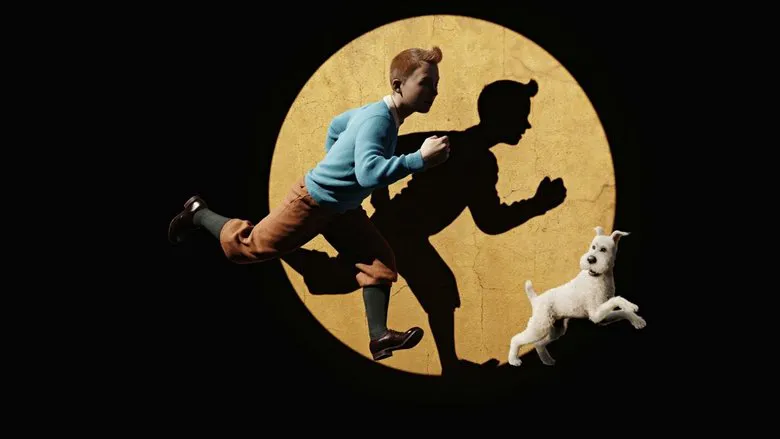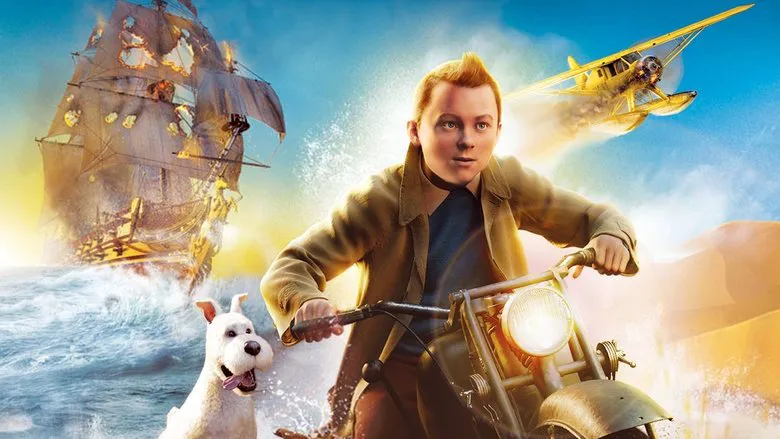The Adventures of Tintin: A Spielbergian Homage to Hergé
Based on Hergé’s iconic comics “The Crab with the Golden Claws,” “The Secret of the Unicorn,” and “Red Rackham’s Treasure,” The Adventures of Tintin follows the intrepid Belgian reporter Tintin (Bell) and his clever dog Snowy as they uncover lost family treasures and forge an unlikely friendship with the perpetually tipsy Captain Haddock (Serkis).

Some film critics argue that all art is ultimately a self-portrait. If that’s the case, the animated duo of Tintin – the globe-trotting, resourceful journalist of indeterminate age – and Captain Archibald Haddock – the frequently inebriated, disaster-prone seafarer armed with (almost) unquenchable optimism – can be seen as a reflection of the friendship and partnership between Steven Spielberg (our Tintin) and producer Peter Jackson (our Haddock).
It was the New Zealand producer who convinced the American director, fresh from the Kingdom of the Crystal Skull, to embark on this cinematic adventure. Spielberg imbues Hergé’s timeless hero with the heart of a teenager, the cunning of an artist, and the wisdom of a film buff. And it hardly matters that Tintin is rendered with computer animation. Jackson, a lifelong Tintin fan, had long admired the heroic (but not superheroic) escapades of the ageless “Belgian Morrissey,” while Spielberg only became interested in the character when a French critic (of course!) compared Raiders of the Lost Ark to the comic book icon beloved across Europe.
A Nod to the Masters
The film’s tone is set by the opening credits, reminiscent of the French New Wave. Accompanied by John Williams’ dynamic piano score, Tintin’s silhouette sneaks past giant typewriters and former adversaries in an animated sequence à la Saul Bass, echoing the prelude to Catch Me If You Can. The interplay of contrasts is delightful: old-school romantic cinema is resurrected through the magical synthesis of computer technology.

A Digital Wonderland
Most importantly, the film captures the delightful essence of Hergé’s vibrant world, filled with thrilling adventures and ancient lore whispered on every corner. Spielberg’s first foray into animation (let’s call it that) transforms the formal and elegant Belgian comic into a digital wonderland. Retaining the distinctive chins and noses of Hergé’s caricatured characters, Weta Digital has managed to create a whimsical variation of near-photographic reality. Spielberg’s vision, fueled by Jackson’s audacity, is realized: like a schoolboy liberated from the confines of the classroom, the director unleashes his creativity almost entirely. Here, we finally see the powerful tools the director has at his disposal. Spielberg reaches a creative zenith through combined shots and dissolves: we see reflections on blades, bubbles, and the bottom of a whiskey bottle that transforms into a telescope, a desert that becomes a raging ocean. Through the sunny spectacle, we glimpse the rainy noir of Jules Dassin, the self-deprecating humor of Indiana Jones, and the slapstick comedy of silent film police.
The Essence of Tintin
The film opens in a city resembling Paris, in an era reminiscent of the 1930s. In Hergé’s world, it’s a mythical, timeless place: cobblestone streets, shuttered windows, elderly ladies walking decadent dogs, and – for the eagle-eyed cinephile – a nod to Robert Bresson’s Pickpocket (1959), a classic of French cinema. We are introduced to Tintin in a scene so hilarious that spoiling it would be a sin. Of course, fans have debated how Tintin should be portrayed on film. It’s no easy task, as the Belgian artist made the hero a “blank slate” onto which we project our dreams. Spielberg and the trio of British screenwriters – Steven Moffat (Doctor Who), Edgar Wright (Scott Pilgrim), and Joe Cornish (Attack the Block) – bravely trust the source material.

A Familiar Face
Jamie Bell imbues Tintin with a neutral English accent and youthful energy, but the hero remains somewhat undefined. Depending on their own age, viewers might place Tintin anywhere from 15 to 30 years old. His face is pleasant but unremarkable, his cheeks barely flushed, his eyes expressive and bright (forget Robert Zemeckis’ dead-eye syndrome). The unruly tuft of hair that gives Tintin’s shadow its iconic status is as defining for the character as the hat is for Indiana Jones.
We know that Indy is an easily excitable archaeologist, while Tintin’s profession is described exhaustively: a traveling reporter who never writes articles! However, as Harry Thompson notes in his excellent biography Hergé: Tintin: The Complete Companion, the writer-artist drew inspiration from the adventure-seeking reporters of the 1920s, who themselves generated news. And this guy has a nose for stories: no sooner does Tintin stroll through a French market than he finds himself embroiled in the mystery surrounding the Haddock family’s disguised inheritance and the sinister Sakharine (Daniel Craig) with his utterly Mephistophelian beard.
A Colorful Cast
Tintin himself may be unassuming and abstract, but his companions are a collection of Dickensian eccentrics and oddballs. Snowy, the faithful fox terrier, whom the director could easily have mishandled, is portrayed as the smartest dog in town, periodically pulling his owner back from the brink, but not as an unnatural Scooby-Doo. And you shouldn’t leave a sandwich unattended in his presence. In short, children will love this dog.
The script tries hard to amuse us. The worst Interpol detectives, played by the comedic duo of Simon Pegg and Nick Frost, offer us farce and idiocy with varying degrees of success. The far funnier Professor Calculus remains in a supporting role, awaiting the sequel, which Peter Jackson will direct.
The film lacks Hergé’s political satire, as well as scenes in which the Belgian artist looks skeptically at the world, whose characters are so dependent on his style that translating these moments of insight into film is almost impossible. In addition, performance capture shifts the focus of the film towards endless chases. Here, someone is always chasing someone else, the plot follows, and no one is allowed to catch their breath. The viewer is expected to run alongside, but only if they want to. Bathing in the luxury of Hergé’s invented universe, the film begs you to join in. Only a very cruel heart could resist.